Centuries of indoctrination about the difference between cultivated land and forest wilderness have to be put aside to properly understand the richness of the forest for human society. The African rainforest, for example, grew toward its current extent beginning around 9,000 years ago and came to offer a vast diversity of food, from small animals and fish to mushrooms, insect larvae, honey, cola nuts, root tubers, and wild fruits. For the Okiek, who live in the Mau rainforest of Kenya, meat from the forest animals comprises 75 percent of their diet, but, socially, it is honey that determines their territorial understanding. The main lineage territory, the konoito, is used to demarcate honey, not game, rights. The territory is subdivided into two dozen or more sections of from 1 to 10 square miles, each assigned to individual families. These konoito extend up the mountain, giving lineages equal access to the differing forest environments. As the bees follow the flowers up the mountain, the Okiek follow the bees.27
Another forest-based society, the so-called “Pygmies,” are part of a set of tribes called the Bambuti, the Batwa, the Bayaka, and the Bagyeli (“Ba-” means “people”), who live scattered over a large area in central and western Africa, in the Democratic Republic of Congo, Congo, Cameroon, Gabon, Central African Republic, Rwanda, Burundi, and Uganda (Figure 3.17). When they developed is not known. Some anthropologists suggest that cultures only gradually acclimatized themselves to the forest, having preferred to live at the perimeter closer to the savanna where there was a greater variety of available food. But it is most likely that as the forests began to grow in the early Holocene, so too did these forest societies.
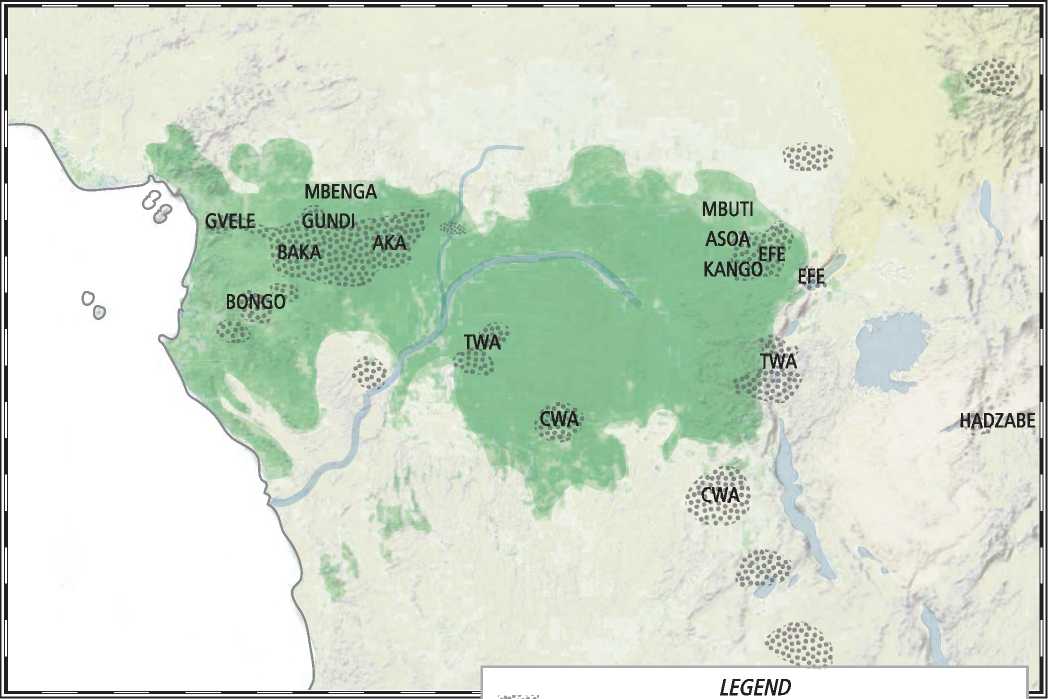
TRIBES
Figure 3.17: African rainforest societies. Source: Florence Guiraud
TROPICAL RAINFOREST WOODLAND SAVANNA
SAVANNA GRASSLAND STEPPE
Today the various cultures of the African forest survive only in relatively isolated pockets and speak different languages, mostly related to those of neighboring peoples with whom they have interacted. There are, however, concepts that are shared between even widely separated tribes. One of these is that of the forest spirit—Jengi, Mugu, Nejunzi, Djengi, and other names—whose power is thought to emanate through the world. Jengi is seen as a parental figure and guardian. He has no consort or family except for the humans, who are defined as his children. Though a positive force, he can fall asleep, providing an opening for bad things to happen. On such occasions, the men of the Bambuti perform a ritual in which they sing through the night until dawn in order to “awaken the forest.”28 The ceremony, known as the Molimo, can last up to four nights. It begins with food and firewood gathered from every hut in the camp to signify the unity and cooperation in invoking the Molimo, which is a ritual wooden trumpet hidden in the forest. The men then light and gather at the “hearth of the Molimo”—called “Kumamolimo”—at the center of the camp and begin to sing. Meanwhile, the young men of the camp leave the fire and go to retrieve the trumpet from the forest. It is not considered a particularly sacred object, but is, nonetheless, kept in a secret place hidden from the women. The young men carry it back to the settlement, stopping along the way to immerse it in water so that the trumpet can drink and rubbing it with leaves and dirt as a symbol of water, earth, and air. When the youths arrive at the camp, they circle its periphery. Dressed with branches, they rush about in the darkness to the sound of the blaring trumpet and, armed with twigs, whack at the huts to express the animation of the forest. Women and children must stay in their huts with the door closed. When the singing is most intense, the youths enter the fire area with the trumpet, adding its sound to that of the others. Depending on how well everyone dances and sings, the trumpet might stay only a few minutes or all night. After leaving, the Molimo is again stored in a tree until its next use.29 The ceremony includes parts that involve the women, but ends with the women retreating to the huts and men finishing the song. The music is very complex and includes continuous improvisations and polyphonic expressions (Figure 3.18).
Figure 3.18: Tribal dance of forest spirits, Republic of Congo. Source: Michael Nicholas/National Geographic Stock
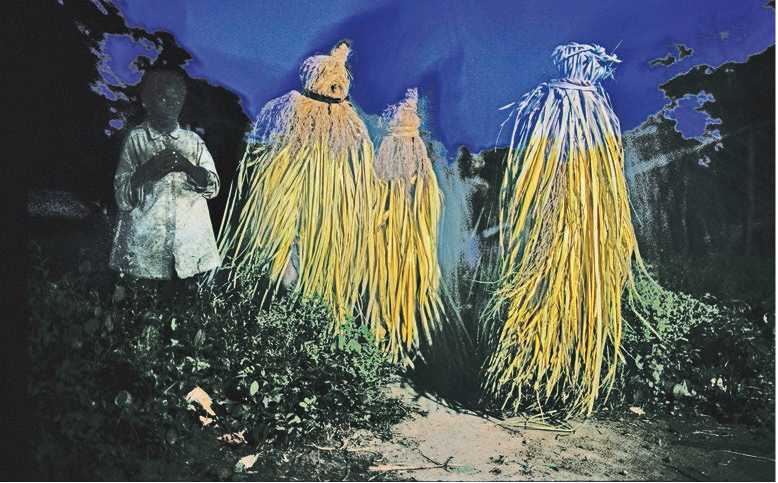
Even though the Bambuti believe in a range of all-encompassing forest deities and magical spirits, they do not worship particular rocks or trees. Individual tribes do, however, have animal totems and thus “see” themselves through the eyes of certain animals.
Society is organized around individual households (endu) consisting of a husband, a wife, and their children. Families are patrilineal, meaning they trace their lineage through the male line to a common male ancestor. But Bambuti society has no ruling group or lineage. Settlements can number to about fifty residents. Bambuti camps usually have two to three times as many people because the net hunting that they do requires communal participation. According to their ethics, it is prohibited to kill more animals than is absolutely necessary for the provision of food. If a man kills an animal for mere pleasure or in order to lift his status in the community, this act will be considered a crime. Normally the men hunt alone, frequently now accompanied by their hounds.
Figure 3.19a, b: Bambuti (or Mbuti), Ituri Forest, Congo: (a) site map, (b) village plan. Source: Andrew Ferentinos/Colin M. Turnbull, The Forest People (New York: Simon and Schuster, 1962)
Their dress is composed of a belt wound around the waist, with a piece of bark cloth attached to the belt in the middle of the back, brought down between the legs and fixed against the belt in front. Usually, however, they go naked, some of them wearing a brass-wire bangle. The family unit makes no claim to territory, but each band as a unit has an understanding of its appropriate territorial range. An individual may, however, stake his claim to a tree that he believes will yield honey but even that does not give that individual exclusive ownership. It simply conveys the right for that individual to have the first opportunity for collecting honey. Once the honey is collected it is done collectively and the claimant is subject to all the usual rules governing the sharing of forest produce. His share might be larger, assuming he is there to claim it.
Women are responsible for providing food, getting water, and constructing the huts. When they establish a settlement, they clear a piece of land near a stream of undergrowth, small trees, and saplings, leaving the canopy-forming trees intact. This protects the settlement from the powerful tropical sun. Furthermore, when the group leaves at the end of the season, the area
Apa Lelo
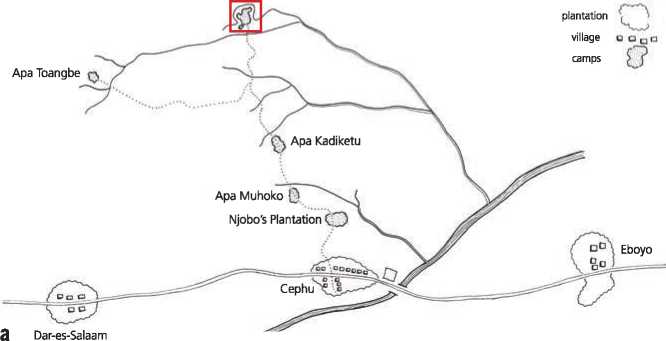
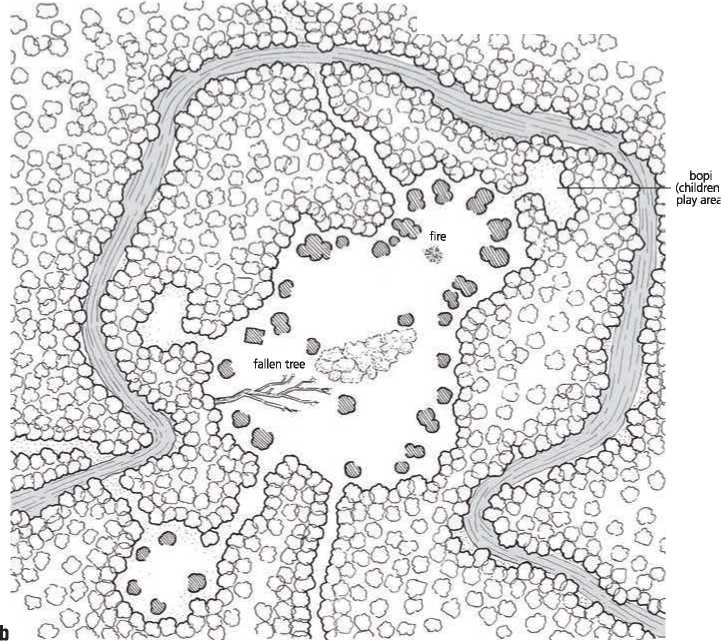
Can quickly return to semi-primary forest. For their houses, the women first stake a pair of saplings for the diameter of the house and tie them together at the center (Figure 3.19a, 3.19b). Ninety degrees to this she produces another arch, these forming the frame on which the other arches are tied to produce the circular hut. Vines are wrapped around horizontally that serve to hold the leaves. The opening can be small or large. The heart-shaped mongono leaves that were collected by the men are slit so that they can be hooked together and hung from the framework. Large unbreakable leaves of Sarcophrynium and Megaphrynium are also used.30 Several women sometimes do the thatching. Some hang the leaves from the outside, working upward, while others on the inside push the leaves through the lattice frame to fasten them. With time the leaves flatten out and become quite watertight. Eventually, however, the leaves dry out and curl and the hut will have to be repaired. One of the daily activities, in fact, is the replacement of the leaves. The size of the house depends on how many are in the family. Smaller huts are round, but those for bigger families tend to be oblong (Figures 3.20 and 3.21). People sleep on a layer of dry leaves and sticks placed on the ground. A family’s possessions—bowls, baskets, carrying belts, cooking utensils, and so on—are placed at the perimeter of the hut or hung from the structure. Usually the fire is outside the entrance, although in the rainy season it is put on the inside. Very little is eaten raw, even the vegetables.31
> Figure 3.20: Bambuti (or Mbuti), Ituri Forest, Congo, hut construction. Source: Andrew Ferentinos/Pygmies of the Rain Forest. DVD. Directed by Kevin Duffy. 1975; Santa Monica, CA: Pyramid Media, 2000
Figure 3.21: Bambuti (or Mbuti), Ituri Forest, Congo, hut construction and plan. Source: Illustrator: Andrew Ferentinos/ Pygmies of the Rain Forest. DVD. Directed by Kevin Duffy. 1975; Santa Monica, CA: Pyramid Media, 2000
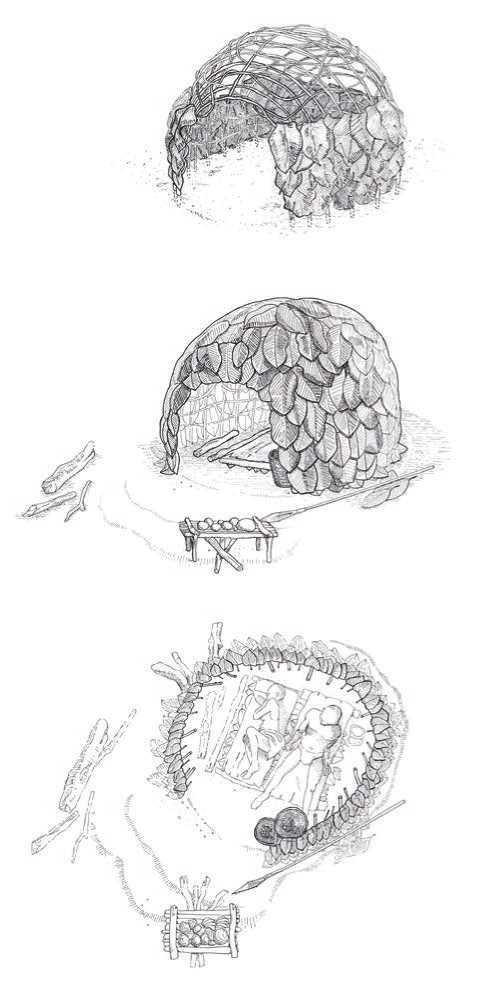
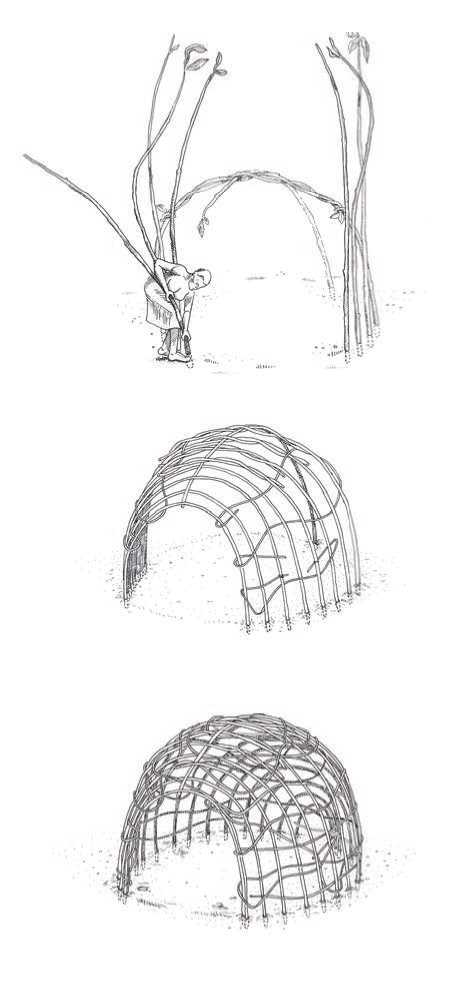
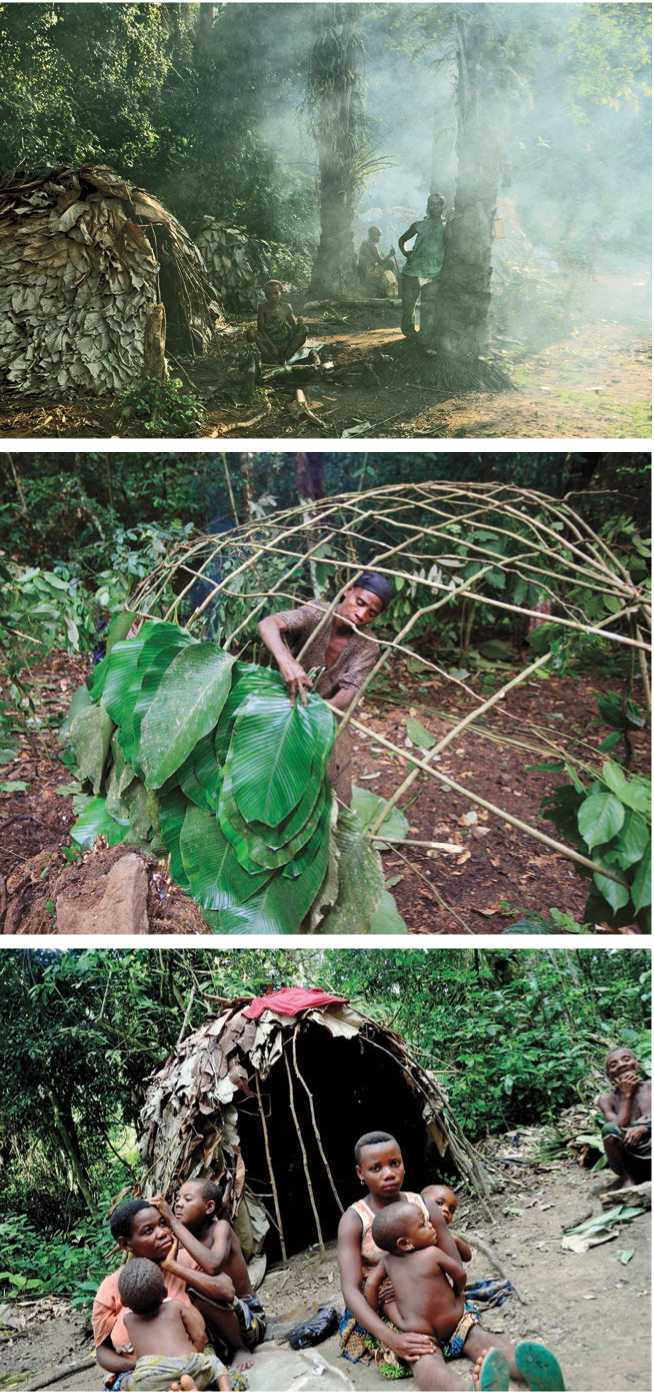
Camps are hardly always peaceful. Feelings of being ignored, memories of good or bad events, new friendships, and problems with relatives all play themselves out in the arrangement of the huts, which, as a result, are often in a state of flux.32 The location of entrances will get changed, for example, depending on friendships. Women who are friendly with one another will have facing entrances. If there is a disagreement, an entrance will be reoriented away from the ofiending person, which can create a complex ripple efiect through the settlement. Every camp has a designated play area {bopi) for children. It is next to a stream and ofi-limits to adults. Here children play games and develop group dynamics. An important event is the honey festival. Women form an inner ring and circle around a bonflre, while men form an outer ring and circle in the opposite direction. The men pretend to seek honey and come near the women. The women play the role of bees, humming and droning. They pick up burning branches from the flre, with which they threaten the men to remind them of the dangers of bee stings.
In death, the practice is to scratch a shallow hole in the floor of the hut and bury the deceased person there on the same day as he or she died, pulling down the hut over the grave. The camp is then abandoned with nothing left behind to indicate the grave site. Nothing is buried with the body except perhaps a few personal belongings such as a bracelet or necklace. All the other property is divided before the camp is abandoned. Though this might sound informal, the association of the deceased with the hut in which he or she lived, plus the dismantling of the camp, are clear indicators of the intimate relationship between death and space33 {Figures 3.22, 3.23, and 3.24).
Hunting rituals are quite elaborate. Some rites are made to locate and to attract game; others designate the hunters who will make the kill, others facilitate tracking. For divination, an initiated female collects ritual substances such as bark and leaves and rubs them in her palms until they stick together. The direction in which the hand points indicates where game is to be found, but there are other systems as well. Special songs are sung that will attract the beast, and special liquids applied ceremoniously to the body of the hunter to make him invisible to the animal. Appeals are made to ancestor
K Figure 3.22: A Bambuti village, Democratic Republic of Congo. Source: Bruno Zanzottera
V Figure 3.23: Baka woman using Ngongo leaves to make her hut, Cameroon. Source: Minden Pictures/SuperStock < Figure 3.24: A Bambuti family in front of their hut, Democratic Republic of the Congo. Source: Matthew Allison
Spirits who are thought to now govern animal populations. Drinks are prepared that give him visionary powers. After the hunt the master-hunter makes an offering to the protective spirits.34
Around 1000 bce, the forest saw the arrival from the north of a host of Bantu newcomers, who brought with them their unique mixture of agriculture and livestock. They were village people. Over the millennia, their ancestors gradually expanded into the forest and today many Bambuti live in a give-and-take relationship with these villagers, providing services in exchange for various food items. The Bambuti have maintained their traditions, but the cultural differences are pronounced and illuminating. For the villagers, the rite to manhood is integrated into the connection to the dead, as only the initiated will join the ancestors when they die. For the Bambuti being a man is more dependent on practical concerns. A boy makes the transition when he proves himself capable of killing his first real game, for this demonstrates that he can sustain a family. For the villagers, the woman’s first menstrual blood is seen as an evil omen that places the girl and her relatives in danger. For the Bambuti, blood means life and announces the fact that the girl is now a potential mother. The event is marked by special songs and seen as a happy occasion for all. For the Bambuti, death is an important but not a mysterious event. The villagers see death as unnatural and see its cause in the sorcery of a person’s enemies. The economic, kinship, and political relationships that bind the Bambuti together as a society in the forest do not apply in the village. For the Bambuti, fetching wood, making buildings, and working in the fields for the villagers are seen by the Bambuti as how they trick the villagers—who are viewed by the Bambuti as animals—to feed them. The villagers for their part see the Bambuti as primitives and as a convenient source of labor. The villagers also see the forest as a dangerous and wild place and attempt to exert control over the Bambuti through their traditions of sorcery. As far as the Bambuti are concerned, it is the villagers who are inferior since they are not of the forest.
The relationship between the Bambuti and their Bantu neighbors gives a clear picture of the cultural divide between First Society people and agriculturalists. There are clear parallels with the! Kung in their encounter with the Bantu. Here, however, the interaction, up until recently, was relatively more balanced, since not only were the Bambuti backed up by the dense forest, but each side, despite its dismissive attitude to the other, developed a culture of negotiation. While this is partially true among the! Kung, there the gradual assimilation into the Bantu world reduced the numbers of those who held on to the old ways.




 World History
World History









